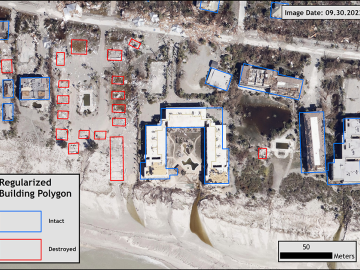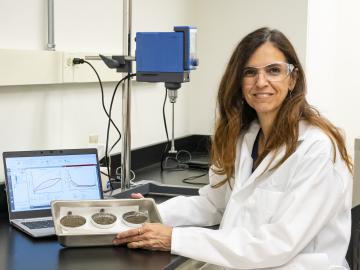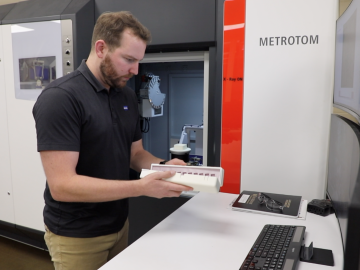
Filter News
Area of Research
- (-) Energy Science (211)
- (-) National Security (25)
- Advanced Manufacturing (24)
- Biology and Environment (129)
- Biology and Soft Matter (1)
- Building Technologies (5)
- Computational Biology (1)
- Computational Engineering (3)
- Computer Science (9)
- Electricity and Smart Grid (1)
- Energy Sciences (1)
- Functional Materials for Energy (1)
- Fusion and Fission (12)
- Fusion Energy (3)
- Isotope Development and Production (1)
- Isotopes (3)
- Materials (126)
- Materials Characterization (1)
- Materials for Computing (19)
- Materials Under Extremes (1)
- Mathematics (1)
- Neutron Science (41)
- Nuclear Science and Technology (8)
- Quantum information Science (2)
- Supercomputing (96)
- Transportation Systems (1)
News Topics
- (-) 3-D Printing/Advanced Manufacturing (81)
- (-) Buildings (38)
- (-) Environment (59)
- (-) Machine Learning (18)
- (-) Materials Science (29)
- (-) Mercury (3)
- (-) Microscopy (8)
- (-) Summit (6)
- Advanced Reactors (7)
- Artificial Intelligence (19)
- Big Data (11)
- Bioenergy (28)
- Biology (14)
- Biomedical (7)
- Biotechnology (5)
- Chemical Sciences (14)
- Clean Water (8)
- Composites (17)
- Computer Science (41)
- Coronavirus (14)
- Critical Materials (9)
- Cybersecurity (25)
- Energy Storage (71)
- Exascale Computing (2)
- Fossil Energy (2)
- Frontier (2)
- Fusion (2)
- Grid (43)
- High-Performance Computing (10)
- Hydropower (3)
- Isotopes (1)
- Materials (36)
- Mathematics (2)
- Microelectronics (1)
- Molten Salt (1)
- Nanotechnology (9)
- National Security (37)
- Neutron Science (15)
- Nuclear Energy (11)
- Partnerships (16)
- Physics (2)
- Polymers (11)
- Quantum Science (3)
- Security (15)
- Simulation (4)
- Space Exploration (3)
- Statistics (1)
- Transportation (68)
Media Contacts

Three researchers at ORNL have been named ORNL Corporate Fellows in recognition of significant career accomplishments and continued leadership in their scientific fields.

The presence of minerals called ash in plants makes little difference to the fitness of new naturally derived compound materials designed for additive manufacturing, an Oak Ridge National Laboratory-led team found.

Stor4Build is a new consortium focused on energy storage for buildings that will accelerate the growth, optimization and deployment of storage technologies.

Oak Ridge National Laboratory scientists designed a recyclable polymer for carbon-fiber composites to enable circular manufacturing of parts that boost energy efficiency in automotive, wind power and aerospace applications.
Researchers at ORNL have developed a tool that provides accurate measurements and positioning directions to those installing energy-efficient panels over existing building exteriors. This method will decrease installation time and cost by more than 25%.

As the United States shifts away from fossil-fuel-burning cars and trucks, scientists at the Department of Energy’s Oak Ridge and Argonne national laboratories are exploring options for another form of transportation: trains. The research focuses on zero-carbon hydrogen and other low-carbon fuels as viable alternatives to diesel for the rail industry.

Having lived on three continents spanning the world’s four hemispheres, Philipe Ambrozio Dias understands the difficulties of moving to a new place.

Over the past seven years, researchers in ORNL’s Geospatial Science and Human Security Division have mapped and characterized all structures within the United States and its territories to aid FEMA in its response to disasters. This dataset provides a consistent, nationwide accounting of the buildings where people reside and work.

Materials scientist Denise Antunes da Silva researches ways to reduce concrete’s embodied carbon in the Sustainable Building Materials Laboratory at ORNL, a research space dedicated to studying environmentally friendly building materials. Credit: ORNL, U.S. Dept. of Energy

A new deep-learning framework developed at ORNL is speeding up the process of inspecting additively manufactured metal parts using X-ray computed tomography, or CT, while increasing the accuracy of the results. The reduced costs for time, labor, maintenance and energy are expected to accelerate expansion of additive manufacturing, or 3D printing.


